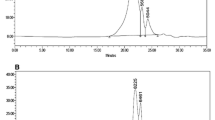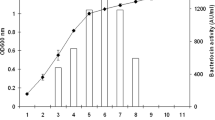Abstract
Growth and enterotoxin production of three strains of Campylobacter jejuni or Escherichia coli known to produce heat labile enterotoxins were evaluated when added into a lactic acid-fermenting cereal gruel, togwa. A single strain of each of the enteropathogens was simultaneously inoculated with a lactic acid starter culture (sc) to reach a level of about 107 c.f.u./ml and was left to ferment for 48h. Gruels without sc (control gruel), pure cholera toxin in fermenting or control gruel and the test bacteria inoculated into nutrient broth were used as positive toxin controls; gruel without inoculated test bacteria was the toxin-negative control. Viable colonies were counted by spread plating 0.1ml of gruel subsamples collected at intervals during the fermentation period onto different selective media and the heat labile enterotoxin production was evaluated using an assay on Chinese hamster ovary (CHO) cells. In the fermenting gruels, no viable cells of the C. jejuni and E. coli strains were detected after 8 and 24h incubation, respectively, but inocula increased in number or remained at the initial level in the control gruel and in the nutrient broth. After 24h incubation, all supernatants of control gruels with inoculated bacteria showed enterotoxicity to the CHO cells (indicated by elongation of 20–50% of the cells). No toxin activity was observed in the fermenting gruels with or without added bacteria or in control gruel alone. Pure cholera toxin added to control gruel caused the enterotoxigenic effect in 70–100% of the CHO cells, but no activity was detected when it was added to the fermenting gruel. The CHO cells were affected instead by a low pH level but were not elongated. Adjusting the pH of fermented gruels to approximately neutral levels restored the toxin effect when cholera toxin was added but not in the presence of added test bacteria. We conclude that lactic acid fermented cereal gruels with pH ≤4 have a high potential to inhibit the growth of enteropathogenic bacteria of the genera C. jejuni and E. coli and to inhibit production of heat labile enterotoxins. Regular consumption of fermented cereal weaning foods will therefore reduce transmission of enterotoxin-producing bacteria, and ingestion of enterotoxins.
Similar content being viewed by others
References
Barber, L.E. & Deibel, R.H. 1972 Effect of pH and oxygen tension on Staphylococcal growth and enterotoxin formation in fermented sausage. Applied Microbiology 24, 891–898.
Beuchat, L.R. 1985. Efficacy of media and methods for detecting and enumerating Campylobacter jejuni in refrigerated chicken meat. Applied and Environmental Microbiology 50, 934–939.
Black, R.E., Brown, K.H., Baker, S., Abdul Alim, A.R.M. & Merson, M.H. 1982 Contamination of weaning foods and transmission of enteropathogenic E. coli diarrhoea in children in rural Bangladesh. Transactions of Royal Society of Tropical Medicine and Hygiene 76, 259–264.
Black, R.E., de Romana, G.L., Brown, K.H., Bravo, N., Bazalar, O.G. & Kanashiro, H.C. 1989 Incidence and etiology of infantile diarrhoea and major routes of transmission in Huascar, Peru. American Journal of Epidemiology 129, 785–799.
Chan, S.T.H., MacKenzie, A.M.R. & Fuite, L.A. 1987 Modified blood-free selective and enrichment media for isolation of thermophilic Campylobacter. In Campylobacter IV, Proceedings of the 4th International Workshop on Campylobacter Infections, eds Kaijser, B. & Falsen, E. pp. 83. Göteborg, Sweden: Göteborg University.
Chordash, A. & Potter, N.N. 1976 Stability of Staphylococcal enterotoxin A to selected conditions encountered in foods. Journal of Food Science 41, 906–909.
Daeschel, M.A., Andersson, R.E. & Fleming, H.P. 1987 Microbial ecology of fermenting plant materials. FEMS Microbiology Reviews 46, 357–367.
Domenech, A., Hernandez, F.J., Orden, J.A., Goyache, J., Lopez, B., Suarez, G. & Gomez-Lucia, E. 1992 Effect of six organic acids on staphylococcal growth and enterotoxin production. Zeitschrift für Lebensmittel Untersuchung und Forschung 194, 124–128.
El-Sawy, M., Gamal, R.F., Naguib, K. & Sharaf, O.M. 1986 Viability of Staphylococcus aureus and presence of TNase & enterotoxins in Egyptian Zabady during manufacturing and storage at different temperature. Annals of Agricultural Sciences, Faculty of Agriculture, Ain Shams University, Cairo, Egypt 31, 53–67.
Gomez-Lucia, E., Goyache, J., Blanco, J.L., Garayzabal, F.F., Orden, J.A. & Suarez, G. 1987 Growth of Staphylococcus aureus and enterotoxin production in homemade mayonnaise prepared with different pH values. Journal of Food Protection 50, 872–875.
Gomez-Lucia, E., Goyache, J., Orden, J.A., Domenech, A., Hernandez, F.J., Quiteria, J.A.R.-S., Lopez, B., Blanco, J.L. & Suarez, G. 1992 Growth of Staphylococcus aureus and synthesis of enterotoxin during ripening of experimental Manchegotype cheese. Journal of Diary Science 75, 19–26.
Granum, P.E., Tomas, J.M. & Alouf, J.E. 1995 A survey of bacterial toxins involved in food poisoning: a suggestion for bacterial food poisoning toxin nomenclature. Food Microbiology 28, 129–144.
Hutton, P.A., Chehak, P.A. & Hanlin, J.H. 1991 Inhition of botulinum toxin production by Pediococcus acidilactici in temperature abused refrigerated foods. Journal of Food Safety 11, 255–267.
Kato, T., Nosaka, H., Katsumine, C., Shiga, I. & Sato, Y. 1990 Effect of anaerobic incubation on Staphylococcal growth and enterotoxin production in fermented sausage. Journal of Japanese Society of Food Science and Technology 37, 396–402.
Kingamkono, R., Sjögren, E., Svanberg, U. & Kaijser, B. 1994 pH and acidity in lactic-fermenting cereal gruels: Effect on viability of enteropathogenic microorganisms. World Journal of Microbiology and Biotechnology 10, 664–669.
Kingamkono, R., Sjögren, E., Svanberg, U. & Kaijser, B. 1995 Inhibition of different strains of enteropathogens in a lactic-fermenting cereal gruel. World Journal of Microbiology and Biotechnology 11, 299–303.
Lorri, W. & Svanberg, U. 1994 Lower prevalence of diarrhoea in young children fed lactic acid-fermented cereal gruels. (UNU) Food and Nutrition Bulletin 15, 57–63.
Lorri, W. & Svanberg, U. 1995 An overview of the use of fermented foods for child feeding in Tanzania. Ecology of Food and Nutrition 34, 57–63.
Mahalanabis, D. 1983 Feeding practices in relation to childhood diarrhoea and malnutrition. In Diarrhoea and Malnutrition Interactions, Mechanisms and Interventions, eds Chen L.C. & Scrimshaw, N. pp. 223–234. New York: Plenum Press.
Mensah, P.A., Tomkins, A.M., Drasar, B.S. & Harrison. T.J. 1988 Effect of fermentation of Ghanaian maize dough on the survival and proliferation of 4 strains of Shigella flexneri. Transactions of Royal Society of Tropical Medicine and Hygiene 82, 635–636.
Metaxopoulos, J., Genigeorgis, C., Fanelli, M.J., Franti, C. & Cosma, E. 1981 Production of Italian dry salami: effect of starter culture and chemical acidulation on Staphylococcal growth in salami under commercial manufacturing conditions. Applied and Environmental Microbiology 42, 869–871.
Mosha, A.C. & Svanberg, U. 1983 Preparation of weaning foods with high nutrient density using flour of germinated cereals. (UNU) Food and Nutrition Bulletin 5, 10–14.
Motarjemi, Y., Käferstein, F., Moy, G. & Quevedo, F. 1993 Contaminated weaning food: a major risk factor for diarrhoea and associated malnutrition. Bulletin of the World Health Organisation 71, 79–92.
Naguib, M.M., Mahmoud, S.Z., Sabbour, M.M., Rifat, A.A., Tawfeek, N. & Naguib, K. 1987 Growth and enterotoxin production of enterotoxigenic Staphylococcus aureus in Rascheese during ripening. Egyptian Journal of Food Science 15, 133–139.
Nout, M.J.R., Roumbouts, F.M. & Hautvast, G.J. 1989a Accelerated natural lactic fermentation of infant food formulations. (UNU) Food and Nutrition Bulletin 11, 65–73.
Nout, M.J.R., Rombouts, F.M. & Havellar, A. 1989b Effect of accelerated natural lactic fermentation of infant foods ingredients on some pathogenic microorganisms. International Journal of Food Microbiology 8, 351–361.
Nout, M.J.R. 1994 Fermented foods and food safety. Food Research International 27, 291–98.
Olsen, A., Halm, M. & Jakobsen, M. 1995 The antimicrobial activity of lactic acid bacteria from fermented maize (kenkey) and their interactions during fermentation. Journal of Applied Bacteriology 79, 506–512.
Otero, A., Garcia, M.C., Garcia, M.L. & Moreno, B. 1988 Effect of growth of a commercial starter culture on growth of Staphylococcus aureus and thermonuclease and enterotoxins (C1 and C2) production in growth cultures. International Journal of Food Microbiology 6, 107–114.
Rowland, M.G.M., Barrell, R.A.E. & Whitehead, R.G. (1978) Bacterial contamination in traditional Gambian weaning foods. The Lancet 21, 136–138.
Ruiz-Palacios, G., Torres, N.I., Ruiz-Palacios, B.R., Torres, J., Escamilla, E. & Tamayo, J. 1983 Cholera-like enterotoxin produced by Campylobacter jejuni, characterization and clinical significance. Lancet ii, 250–253.
Svanberg, U., Sjögren, E., Lorri, W., Svennerholm, A.-M. & Kaijser, B. 1992 Inhibited growth of common enteropathogenic bacteria in lactic-fermented cereal gruel. World Journal of Microbiology and Biotechnology 8, 601–606.
Tomkins, A. 1991 Recent developments in the nutritional management of diarrhoea. Nutritional strategies to prevent diarrhoea among children in developing countries. Transactions of the Royal Society of Tropical Medicine and Hygiene 85, 4–7.
Troller, A.J. 1976 Staphylococcal growth and enterotoxin production-factors for control. Journal of Milk Food Technology 39, 499–503.
Willumsen, J.F., Darling, J.C., Kitundu, J.A., Kingamkono, R.R., Msengi, A.E., Mduma, B., Sullivan, K.R. & Tomkins, A.M. 1997 Dietary management of acute diarrhoea in children: Effect of fermented and amylase-digested weaning foods on intestinal permeability. Journal of Pediatric Gastroenterology and Nutrition 24, 235–241.
Author information
Authors and Affiliations
Rights and permissions
About this article
Cite this article
Kingamkono, R., Sjögren, E. & Svanberg, U. Inhibition of enterotoxin production by, and growth of enteropathogens in a lactic acid-fermenting cereal gruel. World Journal of Microbiology and Biotechnology 14, 661–667 (1998). https://doi.org/10.1023/A:1008800701894
Issue Date:
DOI: https://doi.org/10.1023/A:1008800701894




